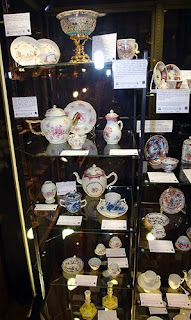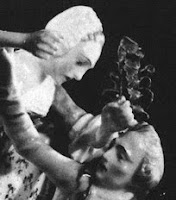A recent purchase was an early Meissen jug and cover, startling in a yellow ground with Japanese kakiemon style flower sprays painted around it.
The piece is early; this shape, with the elegant scroll handle and the large, pointed beak spout was being made by 1720, and this example bears no mark; by about 1723-1725ish, the famous mark of the crossed swords was being used, so can therefore say it is pre-1723. Another point in dating is the paste itself; the first production of true porcelain in Europe, by Böttger in 1709, involved the use of alabaster in the mix; this resulted in a slight creamy-brown colour, very distinctive and known as Bottger porcelain. This jug exhibits a much whiter translucency, indicating a slightly later date with the use of felspar instead of the alabaster; this was just being introduced in the early 1720's.
The pot was therefore made in the 1720-23 period. But what about the decoration?
This drove me to the point of distraction; I had every single book on Meissen out, and even the most obscure possibilities, trying to find a parallel to the stunning design. Not being able to find it was a major problem in being positive in attributing the decoration to the 18th century, and not an unfortunate re-decorated piece of the 19th. I found no example illustrated, not even close - so I examined the yellow ground closely.
The yellow was, of course, the Imperial Chinese colour, reserved for the Emperor himself in Chinese ceramics; naturally, Augustus wanted it from his fledgling Meissen factory. It was amongst the first colour other than blue to be used at the factory, and was announced to be ready in 1726. This then is the earliest date for decoration. However, the yellow ground of the early period was a rich, egg-yolk yellow; this yellow is a pale lemon. Clearly, I had to look farther.
In the Wark collection I found a group of teabowls, C. 1735, with the same pale yellow, so it seems that it was possible to use a pale tone by the early 1730's, pushing the decoration of the jug later still. The other colours compared very well with examples in our collection with early markings from the 1730's, with a turquoise that clumps, and a blue that remains raised and mis-fires easily. I was therefore happy with a date of the mid-1730's for the decoration.
Then there is the question of where; the Hausmalerie (ie 'Home Decorators') were studios scattered throughout Germany which bought blank porcelain from where ever they could, and decorated according to current taste - usually with a distinct style that allows us to identify them. This jug did not fit any of the Hausmalerie studios I could find. In fact, the more I looked, the more convinced I was that this was factory decorated; the technique used, that of leaving a very fine reserve for the flowers to be painted into, was used on many other factory pieces, but purely as secondary sprigs, located on the sides or around the handles of pieces; the main decorative panels were reserved in white, with the subjects - flowers or Chinoiseries - painted within. What we would appear to have in this jug is a very unusual pattern.
I had another piece to compare with, purchased at the same time, a teabowl with exactly the same unusual pattern. This is a mid-1730's piece, with a nice crossed swords mark. It seemed that they were related, probably from a unique service.
As a last resort, I pulled up all the collections of early ceramics that have online catalogues.... and hit the jackpot! In the
Gardiner Museum in Toronto, I found the
rest of the service! Looking carefully at the base of our jug, I could just make out a black number - a collection number - reading G83.1..... - the same beginning sequence as the part service in the Gardiner. This jug & cover has been de-accessed by the museum, but would have been part of the same service. It is slightly smaller than the coffee pot, and larger than the teapot, and would have filled the function of a milk jug. Interestingly, they date the service to 1727-30, allowing for the various marks that the pieces show; crossed swords in underglaze blue, and again in onglaze puce (quite unusual!), and the rarely seen caduceus mark from the mid-1720's. There are clearly a range of dates to the pieces that make up the porcelain of the service; the only thing that unites them is their unique decoration.
The origins of this service I can suggest as follows; an order for kakiemon sprays (possibly with an exact Japanese prototype) has been submitted to the Meissen factory in the mid 1730's; they have been able to fulfill this order with some recent production, but have also delved into the storehouse for some pieces, such as this jug. This was not an uncommon practice, to store old stock and use it many years later.
It's always a thrill to track a piece down and discover a lost history - but not many have such a satisfying conclusion as this piece.
The jug will be exhibited & for sale as part of our
Moorabool Antique Galleries Recent Acquisitions exhibition, to be held in our Geelong premises, opening May 1st, 2010.
















































